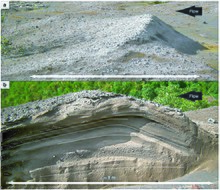Pyroclastic surge
A pyroclastic surge, also referred as a dilute pyroclastic density current, is a flowing mixture of gas and rock fragments ejected during some volcanic eruptions. Pyroclastic surge refers to a specific type of pyroclastic current which moves on the ground as a turbulent flow with low particle concentration (high ratio of gas to rock [1]) with support mainly from the gas phase. Pyroclastic surges are thus more mobile and less confined compared to dense pyroclastic flows, which allows them to override ridges and hills rather than always travel downhill.
The velocity of the head of pyroclastic density currents has been measured directly via e.g. photography as for the case of Mount St. Helens, reaching 90–130 m/s (200–290 mph). Estimates for other recent eruptions range from less than 10 m/s up to 100 m/s.[2] Pyroclastic flows may generate surges. For example, the city of Saint-Pierre in Martinique was overcome by a pyroclastic surge in 1902. Pyroclastic surges can be subdivided into three types: base surge, ash-cloud surge, and ground surge.
Base surge
First recognized after the Taal Volcano eruption of 1965 in the Philippines, where a visiting volcanologist from USGS recognized the phenomenon as comparable to base surge in nuclear explosions.[3] Very similar to the ground-hugging blasts associated with nuclear explosions, these surges are expanding rings of turbulent mixture of fragments and gas that surge outward at the base of explosion columns. Base surges are more likely generated by the interaction of magma and water or phreatomagmatic eruptions.[4] They develop from the interaction of magma (often basaltic) and water to form thin wedge-shaped deposits characteristic of maars.[5]
Ash-cloud surge
Ash-cloud surges are considered the most devastating. They form thin deposits, but travel at great speed (10–100 m/s) carrying abundant debris such as trees, rocks, bricks, tiles etc. They are so powerful that they often blast and erode material (like sandblasting). They are possibly produced when conditions in an eruption column are close to the boundary conditions separating convection from collapse, that is, switching rapidly from one condition to the other.[5]
Ground surge
These deposits are often found at the base of pyroclastic flows. They are thinly bedded, laminated and often cross-bedded.[6] Typically they are about 1 m thick and consist mostly of lithic and crystal fragments (fine ash elutriated away). They appear to form from the flow itself, but the mechanism is not clear. One possibility is that the head of the flow expands through entrainment of air (which is then heated). This then results in the flow front surging forward, which is then over-run by the rest of the flow.[5]

See also
References
- ^ "Glossary of Volcano and Related Terminology". USGS Cascades Volcano Observatory. Retrieved on 2011-04-23.
- ^ Belousov, Alexander; Voight, Barry; Belousova, Marina (2007). "Directed blasts and blast-generated pyroclastic density currents: a comparison of the Bezymianny 1956, Mount St Helens 1980, and Soufrière Hills, Montserrat 1997 eruptions and deposits" (PDF). Bulletin of Volcanology. 69 (7): 701–740. Bibcode:2007BVol...69..701B. doi:10.1007/s00445-006-0109-y.
- ^ See:
- Moore, James G. (1967) "Base surge in recent volcanic eruptions," Bulletin Volcanologique, 2nd series, 30 : 337–363.
- Cas, R.A.F and Wright, J.V., Volcanic Successions Modern and Ancient: A geological approach to processes, products and successions (London, England: Chapman & Hall, 1988), p. 114.
- ^ Becker, Robert John and Becker, Barbara (1998). "Volcanoes", p.133. J.H. Freeman and Company, US. ISBN 0-7167-2440-5.
- ^ a b c Riley, CM. "Pyroclastic Flows and Surges" (PDF).
{{cite journal}}: Cite journal requires|journal=(help) - ^ Douillet, Guilhem Amin; Pacheco, Daniel Alejandro; Kueppers, Ulrich; Letort, Jean; Tsang-Hin-Sun, Ève; Bustillos, Jorge; Hall, Minard; Ramón, Patricio; Dingwell, Donald B (2013). "Dune bedforms produced by dilute pyroclastic density currents from the August 2006 eruption of Tungurahua volcano, Ecuador". Bulletin of Volcanology. 75 (11): 762. doi:10.1007/s00445-013-0762-x. PMC 4456068. PMID 26069385.
- ^ Douillet, Guilhem Amin; Pacheco, Daniel Alejandro; Kueppers, Ulrich; Letort, Jean; Tsang-Hin-Sun, Ève; Bustillos, Jorge; Hall, Minard; Ramón, Patricio; Dingwell, Donald B (2013). "Dune bedforms produced by dilute pyroclastic density currents from the August 2006 eruption of Tungurahua volcano, Ecuador". Bulletin of Volcanology. 75 (11): 762. doi:10.1007/s00445-013-0762-x. PMC 4456068. PMID 26069385.
